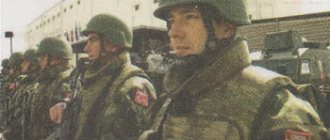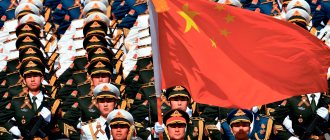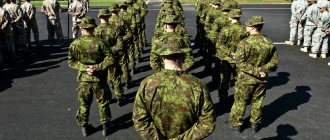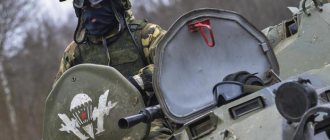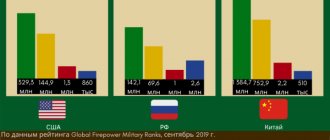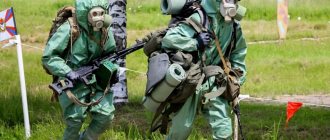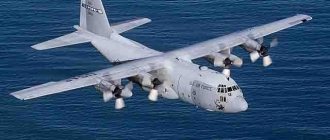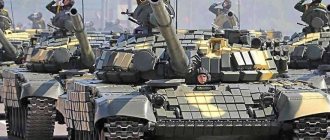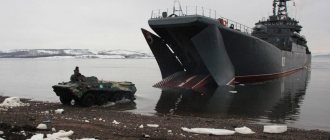The main guarantor of the independence and inviolability of the borders of any state is its armed forces. Diplomacy and economic means are certainly important (and effective) tools of international politics, but only those countries that are able to defend themselves are viable. The entire political history of mankind is proof of this thesis.
The Armed Forces of the Russian Federation (RF Armed Forces) are currently one of the largest in the world in terms of numbers. In rankings compiled by expert groups, the Russian army is usually in the top five, along with the armed forces of China, India, the United States and the DPRK. The size of the Russian army is determined by decrees of the country's president, who, according to the Constitution of the Russian Federation, is the commander-in-chief of the armed forces. Currently (summer 2022) it is 1,885,371 people, including about 1 million military personnel. Today, our country’s mobilization resource is approximately 62 million people.
Russia is a nuclear state. Moreover, our country has one of the largest arsenals of nuclear weapons, as well as sophisticated and numerous means of delivering them. The Russian Federation ensures a closed cycle of nuclear weapons production.
Our country has one of the most developed military-industrial complexes in the world; the Russian military-industrial complex is capable of providing the armed forces with almost the entire range of weapons, military equipment and ammunition, from pistols to ballistic missiles. Moreover, Russia is one of the largest arms exporters in the world, with $14 billion worth of Russian weapons sold in 2022.
The Armed Forces of the Russian Federation were created on May 7, 1992 on the basis of units of the USSR Armed Forces, but the history of the Russian army is much longer and richer. It can be called the heir not only of the armed forces of the USSR, but also of the Russian imperial army, which ceased to exist in 1917.
Nowadays, the recruitment of the Russian armed forces occurs on a mixed principle: both through conscription and on a contract basis. Modern government policy in the field of formation of the armed forces is aimed at increasing the number of professionals serving under contract. Currently, all non-commissioned officers of the RF Armed Forces are completely professional.
The annual budget of the Russian armed forces in 2022 was 3.287 trillion rubles. This is 5.4% of the country's total GDP.
Currently, conscript service in the Russian army is 12 months. Men between the ages of 18 and 27 can be drafted into the armed forces.
History of the Russian Army
On July 14, 1990, the first Russian military department appeared. It was called the “State Committee of the RSFSR for Support and Interaction with the Ministry of Defense and the KGB of the USSR.” After the August putsch in Moscow, the Ministry of Defense of the RSFSR was formed for a short time on the basis of a committee.
After the collapse of the USSR, the United Armed Forces of the CIS countries were formed, but this was a temporary measure: on May 7, 1992, the first Russian President Boris Yeltsin signed a decree on the creation of the Armed Forces of the Russian Federation.
Initially, the RF Armed Forces included all military units located on the territory of the country, as well as troops that were under Russian jurisdiction. Then their number was 2.88 million people. Almost immediately the question of reforming the armed forces arose.
The 90s were a difficult period for the Russian army. Chronic underfunding led to the fact that the best personnel left it, the purchase of new types of weapons practically ceased, many military factories were closed, and promising projects were stopped. Almost immediately after the creation of the Russian armed forces, plans appeared to completely transfer them to a contract basis, but lack of funding for a long time did not allow moving in this direction.
In 1995, the first Chechen campaign began, which demonstrated the catastrophic situation of the Russian army. The troops were understaffed, and the fighting showed serious shortcomings in their management.
In the second Chechen campaign (1999–2006), permanent readiness units, as well as airborne units, took part. In 2003, the share of contract soldiers in Chechnya reached 35%.
Back in the 90s, it was decided to divide all units and formations of the RF Armed Forces into four categories:
- permanent readiness units, staffed by 95-100% of wartime staff;
- reduced-strength units (about 70%);
- storage bases for military equipment and weapons (5-10%);
- cropped units (about 5%).
At the beginning of the 2000s, this reform was continued. It was decided to completely transfer the permanent readiness units to a contract basis, and recruit the remaining units on a fixed-term basis.
The first unit that was completely transferred to a contract basis was one of the regiments of the Pskov Airborne Division. In 2005, a reform of military management began: it was planned to create three territorial commands, under whose subordination all types and branches of the armed forces in a given territory would fall. This reform was actively promoted by Defense Minister Serdyukov, who was appointed to the post in 2007. In addition, back in 2006, a state rearmament program until 2020 was adopted.
In 2008, the Russian Armed Forces took part in the conflict in South Ossetia. He revealed a large number of shortcomings and problems of the modern Russian army. The most serious of them were low troop mobility and poor controllability. After the end of the conflict, the start of military reform was announced, which was supposed to significantly increase the mobility of the Armed Forces units and increase the coordination of their joint actions. The result of the reform was a reduction in the number of military districts (four instead of six), a simplification of the ground forces command and control system, and a significant increase in the army budget.
All this made it possible to speed up the entry of new military equipment into the troops, attract a larger number of contract professionals, and increase the intensity of combat training of units.
During the same period, regiments and divisions began to be reorganized into brigades. True, in 2013 the reverse process began: regiments and divisions began to form again.
In 2014, the Russian army played a key role in the return of Crimea. In September 2022, the operation of the Russian Armed Forces in Syria began, which continues to this day.
Structure of the Russian army
According to the Russian Constitution, the overall leadership of the Russian armed forces is exercised by the Supreme Commander-in-Chief, who is the president of the country. He heads and forms the Security Council of the Russian Federation, whose tasks include developing military doctrine and appointing senior leadership of the armed forces. The president of the country signs decrees on urgent conscription and transfer of military personnel to the reserve, approves various international documents in the field of defense and military cooperation.
Direct control of the armed forces is exercised by the Ministry of Defense. Its main task is to implement state policy in the field of defense, maintain constant readiness of the armed forces, develop the military potential of the state, resolve a wide range of social issues, and conduct events for interstate cooperation in the military sphere.
Currently (since 2012), the Russian Minister of Defense is Army General Sergei Shoigu.
The operational command of the RF Armed Forces is exercised by the country's General Staff. Its head at the moment is Army General Valery Gerasimov.
The General Staff carries out strategic planning for the use of the armed forces, as well as other law enforcement agencies of the Russian Federation. This body is also involved in operational and mobilization training of the Russian army. If necessary, it is under the leadership of the General Staff that the mobilization deployment of the RF Armed Forces takes place.
Currently, the Russian Armed Forces include three types of troops:
- Ground troops;
- Navy;
- Military space forces.
Also an integral part of the RF Armed Forces are the following types of troops:
- Airborne troops;
- Strategic Missile Forces.
- Special troops.
The most numerous are the Ground Forces, they include the following types of troops:
- Motorized infantry;
- Tank;
- Air Defense Forces;
- Rocket Forces and Artillery;
- Special troops.
Ground forces are the backbone of the modern Russian army; they carry out ground operations, seize territories and inflict the main damage on the enemy.
The Aerospace Forces are the youngest branch of the Russian army. The decree on their formation was issued on August 1, 2015. The VKS were created on the basis of the Russian Air Force.
The Aerospace Forces includes the Air Force, consisting of army, front-line, long-range and military transport aviation. In addition, anti-aircraft missile forces and radio engineering troops are an integral part of the Air Force.
Another branch of the military that is part of the Aerospace Forces is the air defense and missile defense troops. Their tasks include warning of a missile attack, managing the orbital constellation of satellites, missile defense of the Russian capital, launching spacecraft, and testing various types of missile and aircraft equipment. The structure of these troops includes two cosmodromes: Plesetsk and Baikonur.
Another component of the Air Force is the Space Force.
The Navy is a branch of the armed forces that can conduct operations in the sea and ocean theaters of war. It is capable of delivering nuclear and conventional strikes against enemy sea and land targets, landing troops on the coast, protecting the economic interests of the country, and conducting search and rescue operations.
The Russian Navy includes surface and submarine forces, naval aviation, coastal troops and special forces units. The submarine forces of the Russian Navy can carry out strategic missions; they are armed with submarine missile carriers with ballistic nuclear missiles.
The coastal forces include units of the marine corps and missile and artillery coastal troops.
The Russian Navy includes four fleets: the Pacific, Black Sea, Baltic and Northern, as well as the Caspian Flotilla.
A separate branch of the military is the Strategic Missile Forces - this is the main component of Russia's nuclear forces. The Strategic Missile Forces are an instrument of global deterrence; it is a guarantee of a retaliatory strike in the event of a nuclear attack on our country. The main armament of the Strategic Missile Forces are strategic intercontinental missiles with mobile and silo-based nuclear warheads.
The Strategic Missile Forces include three missile armies (with headquarters in Omsk, Vladimir and Orenburg), the Kapustin Yar test site, research and educational institutions.
The airborne troops also belong to a separate branch of the military and are the reserve of the Commander-in-Chief. The first airborne units were formed in the USSR back in the early 30s. This branch of the military has always been considered the elite of the army, and it remains so to this day.
The Airborne Forces include airborne and air assault units: divisions, brigades and individual units. The main purpose of paratroopers is to conduct combat operations behind enemy lines. Today, the Russian Airborne Forces include five divisions, five brigades and a separate communications regiment, as well as specialized educational institutions and training centers.
The RF Armed Forces also include special troops. This name refers to the set of units that ensure the normal functioning of the Ground Forces, Aerospace Forces and Navy. Special troops include railway troops, medical service, road and pipeline troops, and topographic service. This branch of troops also includes special units of the GRU.
Ground units
The structure of this division includes several auxiliary departments:
- motorized rifle units;
- artillery;
- tank forces;
- air defense installations.
The main tasks are performed by motorized rifle units. They are responsible for the tasks of a forced, quick attack, reconnaissance and destruction of enemy infantry. The main goal is to capture enemy territories. Tank troops are allocated to support motorized rifle units. They strengthen offensive positions and help protect captured territories.
Tank forces are mostly used for strategic purposes to abruptly break through blockades and echelons. They attack from the flanks or attack head-on. The main advantage of these units is high damage, an armored hull, and the ability to destroy not only enemy military personnel, but also equipment and important enemy defense systems. Disadvantage: lack of maneuverability.
Artillery installations are used to destroy enemy points from a long distance. Artillery is difficult to destroy, so a small amount of equipment and personnel is enough to ensure defense. The destruction of artillery points is complicated by the fact that they are installed in hidden high locations.
Air defenses are used to provide airspace protection while other units are attacking. They prevent mortar strikes from the air, the landing of nuclear missiles, and the release of precision projectiles. Air defenses are capable of shooting down not only bombers, but also enemy cargo or military passenger aircraft.
Territorial division of the RF Armed Forces
Currently, the territory of Russia is divided into four military districts: Western (headquarters in St. Petersburg), Central (headquarters in Yekaterinburg), Southern (Rostov-on-Don) and Eastern with headquarters in Khabarovsk.
In 2014, it was announced the formation of a new military structure - the North strategic command, whose task is to protect Russian state interests in the Arctic. In fact, this is another military district created on the basis of the Northern Fleet. It has land, air and naval components.
Navy
There are several divisions in the naval units. The first is the coastal troops, which guard the Russian-Japanese, Russian-Ukrainian and other maritime borders and defend Russian national interests in the maritime sphere. The composition of military personnel in this unit is significant and almost not inferior to the “dry” unit.
Another service option is the Marine Corps. These soldiers provide security for ships and act as defenders in maritime conflicts. And finally, the sailors themselves who serve on warships.
People who want to serve in the navy are subject to high requirements - tall height, improved health characteristics, developed muscles. The candidate must show that he is mentally stable; It is best if he began preparing for service as a child. Such a policy is associated with a high risk of injury in the maritime fleet and the presence of overload. Due to the increased danger of service, the military of these units retire from 30 years of age.
The fleet is located on all maritime sites accessible to Russian employees - the Black Sea, the Baltic, and the Pacific Ocean. Some employees collaborate or come into contact with navigators from NATO countries.
Armament of the Russian Army
Most types of weapons and military equipment that are currently used by the Russian army were developed and manufactured during the Soviet period. Tanks T-72, T-80, BTR-80, BMP-1, BMP-2 and BMP-3, BMD-1, BMD-2 and BMD-3 - all this was inherited by the Russian army from the USSR. The situation is similar with cannon and rocket artillery (MLRS Grad, Uragan, Smerch) and aviation (MiG-29, Su-27, Su-25 and Su-24). This is not to say that this technique is catastrophically outdated; it can be used in local conflicts against not very strong opponents. In addition, the USSR produced so many weapons and military equipment (63 thousand tanks, 86 thousand infantry fighting vehicles and armored personnel carriers) that they can be used for many years to come.
However, this technology is already significantly inferior to the latest analogues adopted by the armies of the United States, China and Western Europe.
Around the middle of the last decade, new types of military equipment began to enter service with the Russian army. Today, the process of rearmament is actively underway in the RF Armed Forces. Examples include the T-90 and T-14 Armata tanks, the Kurganets infantry fighting vehicle, the BMD-3 airborne combat vehicle, the BTR-82, the Tornado-G and Tornado-S MLRS, the tactical missile system " Iskander", the latest modifications of the Buk, Tor and Pantsir air defense systems. The aircraft fleet is being actively updated (Su-35, Su-30, Su-34). The Russian fifth-generation fighter PAK FA is being tested.
Currently, significant funds are being invested in the re-equipment of Russian strategic forces. Old missile systems, created back in the USSR, are gradually being taken off duty and replaced with new ones. New missiles are being developed (such as the Sarmat). The fourth generation missile-carrying submarines of the Borei project have been put into service. A new Bulava missile system was developed for them.
The Russian Navy is also being rearmed. According to the state weapons development program (2011-2020), the Russian Navy should include ten new nuclear submarines (both missile and multi-purpose), twenty diesel submarines (Varshavyanka and Lada projects), fourteen frigates ( projects 2230 and 13356) and more than fifty corvettes of different projects.
Aviation and elite troops
Aviation can be long-range, front-line and army. Long range hits targets at a great distance. The front line provides an attack, dropping mines directly above the target. Army aviation provides cargo and military personnel. Air defense installations are always used together with aviation (when defending positions).
Individual elite units include space forces, special forces, and privileged structures. They carry out the tasks of ensuring internal and external security, and the space forces are responsible for scientific activities and space exploration.
The military structure of the Russian army is dynamic and may soon undergo reforms again, this is due to modernization, new management requirements, and new opportunities in the technical field.
